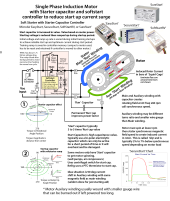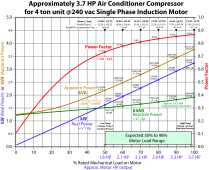There are likely several different methods used to accomplish two stage operation. On the attached video, the motor actually has to stop, equalize refrigerant, and be setup to reverse motor direction by interchanging what are normally called Run and Start windings on compressor motor.
In one rotational direction it mechanically drives two compressor pistons, corresponding to 'high speed'. In the opposite rotational direction, it mechanically drives only one compressor piston for 'low speed'.
The motor is common in high/low speed, running at same RPM speed in both 'low speed' and' high speed' modes, just in different rotational direction. In low speed mode there is just less mechanical load on motor, driving only one piston.
It should be possible to wire in an Easystart soft starter but it must be done such that the Easystart booster capacitor and run wires are connected on AC input side before the Run/Starter winding reversal relay to motor for rotational direction, so the boost cap always goes to assigned start winding and run wire always goes to assigned Run terminal based on desired motor rotational direction. It should be trained in high-speed mode, which has a bit more initial startup mechanical load due to driving two pistons. If you allow softstarter to train itself in low speed mode it may stall out compressor when high speed mode is attempted.
When single phase induction motor has less mechanical loading its electrical input power drops off, but its power factor degrades so the VA apparent power does not drop off as much as real power. Two stage compressors can run down to 35% motor mechanical loading where power factor gets very poor. They may add a power factor correction capacitor across motor in low speed mode to improve low speed mode power factor.
On an air conditioner, as heat loading is reduced due to air temp and humidity, the air handler evaporator expansion valve regulates refrigerant flow to keep evaporator above freezing point of water. With a fixed compressor pumping rate, there is a limit to what the expansion valve can do since the compressor will continue to attempt to draw return refrigerant forcing low side pressure so low it would result in return low pressure side refrigerant line freezing up. Two stage or variable speed compressors are a better way to regulate pumping rate allowing lower heat loading run situations.
Reducing air handler air flow rate with a variable speed blower across evaporator coils allows more time for humidity removal without lowering air temp as much. This is how humidity control is done in addition to just air temp. Removing humidity takes more A/C btu's than just cooling air since causing water vapor to condense to liquid requires more heat removal. As humidity comes down in air-conditioned area the heat loading btu requirement is reduced on system to maintain air temperature.
An oversized A/C unit of fixed speed for given cooling area is bad because it quickly lowers air temp resulting in short ON cycles that gives very little time for evaporator to condense humidity out of air. You end up with a 'cold damp cave' feeling to air-conditioned rooms.
View attachment 100033
View attachment 100034




